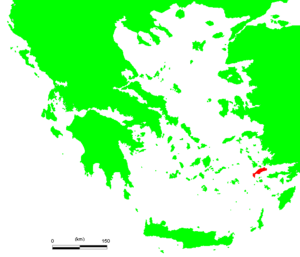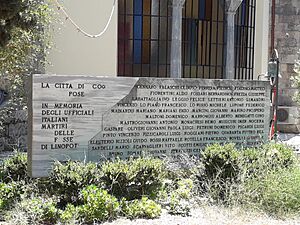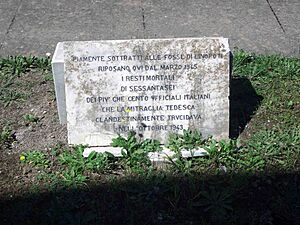Massacre of Kos facts for kids

The Massacre of Kos was a serious war crime that took place in early October 1943. It happened on the island of Kos in the Dodecanese, which was then controlled by Italy. German soldiers from the Wehrmacht killed many Italian army POWs (Prisoners of War). About one hundred Italian officers were shot. This happened because they were seen as traitors for fighting against the German invasion of the island. This invasion was part of the Battle of Kos, which was part of the larger Dodecanese campaign. General Friedrich-Wilhelm Müller gave the orders for these killings.
Contents
Why it Happened
Italy had controlled Kos since 1912, after a war with the Ottoman Empire. During World War II, Kos became important because it had an airfield near Antimachia. On September 8, 1943, Italy signed an agreement to surrender to the Allied forces. This news made both the Italian soldiers and the local people very happy. They hoped the war would end soon.
The few German soldiers on Kos were surprised and easily disarmed. Soon after, more than 1,500 British troops arrived. They came to help the 4,000 Italian soldiers defend the island. They knew a German invasion might happen.
The Battle for Kos
On October 3, German forces began their attack, called Operation Polar Bear. Soldiers from the 22nd Air Landing Division, led by General Friedrich-Wilhelm Müller, landed in three different places on the island. They came from both the sea and the air.
During the battle, the Italian and British forces did not work well together. The RAF could not provide air support. Also, there were not enough anti-aircraft guns. This allowed the German air force, the Luftwaffe, to bomb the island heavily without being stopped. Even though the British and Italian soldiers greatly outnumbered the Germans (about 5,500 vs. 1,000), they surrendered on October 4. In total, 1,388 British and 3,145 Italian soldiers were captured. They were gathered at Neratzia Castle in Kos city.
The Killings
Between October 4 and 6, 148 captured Italian officers faced a quick, unfair trial. These officers were from the 10th Regiment, part of the 50th Infantry Division Regina. Colonel Felice Leggio commanded them. General Müller ordered this trial.
The trial decided that any officers who had stayed loyal to King Vittorio Emanuele III and fought the Germans would be shot. Of the 148 officers:
- Seven joined the Germans.
- 28 managed to escape to Turkey.
- 10 were in the hospital and later sent to camps in Germany.
- The remaining 103 officers were shot by Müller's soldiers. This happened between the evening of October 4 and October 7. The killings took place near the Tigaki salt lake (Alyki).
What Happened Later
In February 1945, 66 bodies were dug up from eight mass graves near Linopotis. They were then buried in the Catholic cemetery of Kos. In 1954, these bodies were moved to Italy. They were reburied in a World War II memorial in Bari.
Many bodies were still missing on Kos. However, no one searched for them until 2015. Then, a group of Greek and Italian volunteers started digging. They found human remains and personal items. These recovered remains were placed in a marble urn at the ossuary of the Catholic cemetery of Kos.
Punishment for General Müller
After the war, General Müller was captured by the Red Army in East Prussia. He was sent to Greece. A military court there sentenced him to death. This was for harsh actions he took against civilians on Crete. He was not punished for the events on Kos. He was executed by firing squad in Athens on May 20, 1947. He was the only person responsible for the massacre who was ever punished.
The Hidden Files
In 1994, during a trial for a former SS officer named Erich Priebke, important documents were found. These documents were about the Kos massacre and many other war crimes. They were hidden in an archive in Rome, in a wooden cabinet facing a wall. People called it the armoire of shame (cabinet of shame).
In 2003, a special group from the government looked into this. They found that in January 1960, the Italian military attorney general, Gen. Enrico Santacroce, had ordered almost 2,000 Nazi war crime files to be put away and forgotten. During the Cold War era, there was strong political pressure. Ministers G. Martino and P. Taviani worried that Germany, which was Italy's ally in NATO, would be upset if these files became public. So, they were kept secret.
See also
- Massacre of the Acqui Division
- SS Oria



